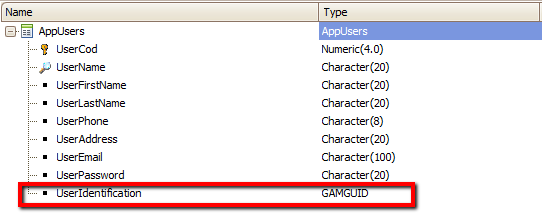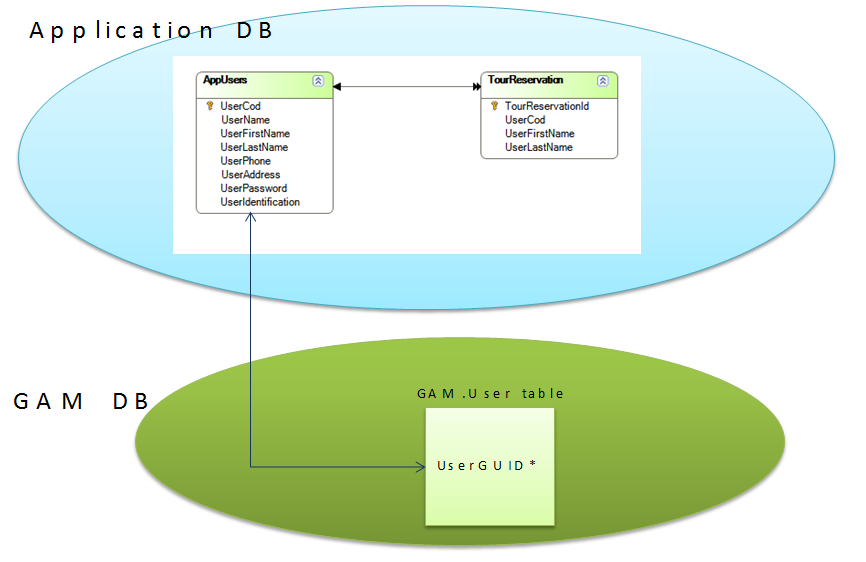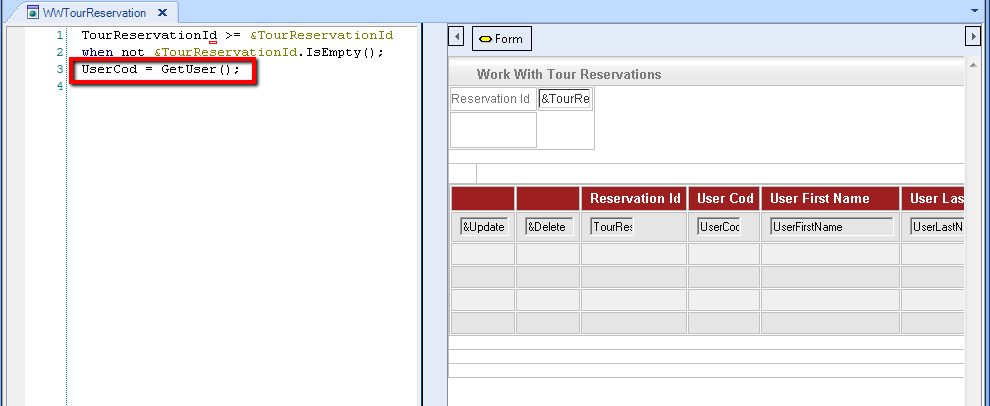In this scenario, a secondary attribute, named UserIdentification and of GAMGUID data type will be added to the application's Users table, linking the users to the GAM database (Figure 2). Note that there are other ways to identify the GAM user other than using GAMGUID.


The UserIdentification attribute can be set as Candidate Key depending on the needs of the application.
In this solution, the users are redundant in the GAM database table and in the application's database AppUsers table, so there must be a mechanism to keep both tables updated. Here you have a way to do it.
1. In order to insert the users of the AppUsers table in GAM database, you need to run a Procedure that scans the AppUsers table and updates the information in the GAM database table (inserts the users in the GAM Repository).
The Procedure Source code would be similar to the following:
For each UserCod
&User.GUID = &UserId //&User is GAMUser data type, &UserId is GAMGUID data type
&User.Name = UserName
&User.FirstName = UserFirstName
&User.LastName = UserLastName
&User.Password = UserPassword
&User.EMail = UserEmail
&User.Save()
if &User.Success()
msg('User added to GAM Repository: ' + &User.Name)
else
&GAMErrors = &User.GetErrors() //&GAMErrors is collection of GAMError data type
do 'ProcessErrors'
endif
Endfor
commit
Sub 'ProcessErrors'
For &GAMError in &GAMErrors
Msg(Format("%1 (GAM%2)", &GAMError.Message, &GAMError.Code))
EndFor
EndSub
2. Then, in the Registration form of the application, you need to update both, the user in the application's database and the same user in the GAM database. So, for each user who is registered, updated, or deleted in the application, you need to update GAM repository.
The following are the rules of the Transaction AppUsers, used to manage the users in this sample:
[web]
{
parm(in:&Mode, in:&UserCod);
UserCod = &UserCod if not &UserCod.IsEmpty();
noaccept(UserCod);
noprompt(UserCod);
}
UpdateGAMUser(UserIdentification,UserName,UserFirstName,UserLastName,UserAddress,UserPhone,UserEmail,&Error)
if update
on aftervalidate;
DeleteGAMUser(UserIdentification,&Error) if delete on aftervalidate;
error('Please enter your Email') if UserEmail.IsEmpty();
[web]
{
accept(&Password);
accept(&PasswordConfirm);
error('Passwords don´t match')
if insert and &Password <> &PasswordConfirm;
RegisterGAMUser(UserName,UserFirstName,UserLastName,UserAddress,UserPhone,UserEmail,&Password,UserIdentification,&Error)
if insert on aftervalidate;
}
error('Data could not be updated, try again please') if &Error on aftervalidate;
- The Procedures RegisterGAMUser, UpdateGAMUser, and DeleteGAMUser have Commit on Exit = No. The idea is to simulate only one LUW, so that the user is updated in both databases (app DB, and GAM DB) or in none of them. That is why the &Error flag is also used, which is returned by those Procedures if there is a failure in GAM database user update.
Download the sample for more details.
- Take into account that if the GAM backend is also used to manage the users, the Web Panels of the GAM backend have to be modified as well, so that the data is updated in the Users table of the application's database.
Sample 1
The following code is an example taken from the RegisterGAMUser Procedure:
&User.Name = &UserName //&User is GAMUser data type
&User.FirstName = &UserFirstName
&User.LastName = &UserLastName
&User.Address = &UserAddress
&User.Phone = &UserPhone
&User.EMail = &UserEmail
&User.Password = &UserPassword
&User.Save()
if &User.Success()
&UserIdentification = &User.GUID //&UserIdentification is GAMGUID data type
&Error = False
else
&GAMErrors = &User.GetErrors() //&GAMErrors is collection of GAMError data type
do 'ProcessErrors'
&Error = True
endif
Sub 'ProcessErrors'
For &GAMError in &GAMErrors
Msg(Format("%1 (GAM%2)", &GAMError.Message, &GAMError.Code))
EndFor
EndSub
parm(in:&UserName,in:&UserFirstName,in:&UserLastName,in:&UserAddress,in:&UserPhone,in:&UserEmail,in:&UserPassword,out:&UserIdentification,out:&Error);
Sample 2 - Filtering a user's data
Suppose that a user has to see only their own TourReservations.
In order to filter only the data related to the user who has logged in, you need to add the following condition to the WWTourReservation Web Panel:
UserCod = GetUser();

Where GetUser is a Procedure that gets the GAM user who is logged in and returns the corresponding UserCod of the application's database:
&User = GAMUser.Get()
&GAMErrors = &User.GetErrors()
if &GAMErrors.Count > 0
do 'ProcessErrors'
else
&UserIdentification = &User.GetId()
for each UserCod
where UserIdentification = &UserIdentification
&UserCod = UserCod
endfor
endif
Sub 'ProcessErrors'
For &GAMError in &GAMErrors
Msg(Format("%1 (GAM%2)", &GAMError.Message, &GAMError.Code))
EndFor
endsub
parm(out:&UserCod);
The same happens when calling the Transaction for registering new TourReservations, you have the following rule, so as the UserCod is instantiated with the user who has logged in:
equal(UserCod, GetUser());
The code of getting the user can also read the user from a Web Session.
Download the sample xpz from here.
HowTo: Mapping Application Users to GAM Users